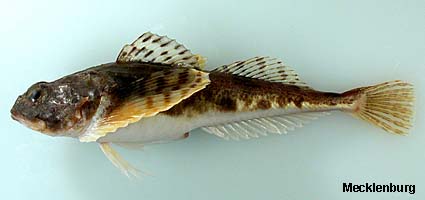Sculpins

Sculpins are grouped in 8 families in the superfamily Cottoidea of the order Scorpaeniformes and comprise about 345 species worldwide. Unlike many other scorpaeniform fishes, most sculpins are not completely covered with typical scales; they are entirely naked, or have partial coverage with a few bands of scales, or the body is covered with prickles which are modified scales. None have bony plates like their close relatives the poachers and alligatorfishes (Cottoidea: Agonidae), or a ventral sucking disk like the lumpsuckers (Cyclopteridae) and snailfishes (Liparidae).
Most sculpins have 2 dorsal fins and 1 anal fin; large, fan-shaped pectoral fins; well-developed pelvic fins; and a truncate (straight) or slightly rounded caudal fin on a long peduncle. The first dorsal fin is supported by stiff spines. Sculpins typically have a broad head and tapering body.
About 36 species of sculpin in 3 families live in the Arctic Ocean and adjacent, seasonally ice-covered waters of the North Pacific and North Atlantic. They primarily inhabit marine coastal waters from shallow depths to about 290 m (950 ft). Sculpins are benthic or demersal as juveniles and adults, and produce their eggs on the bottom. The larvae are planktonic and periodically found offshore. Sculpin diets include crustaceans, molluscs, worms, and fishes, in various proportions.
Page Author: Kitty & Tony Mecklenburg
Updated: Feb 10, 2011








